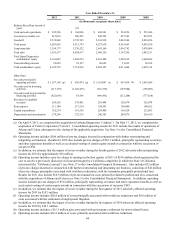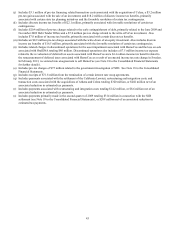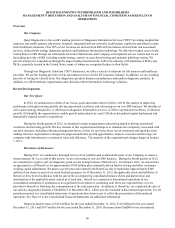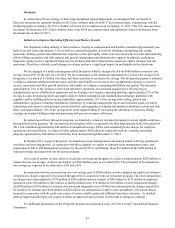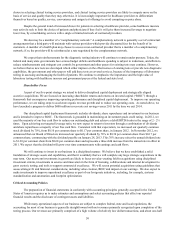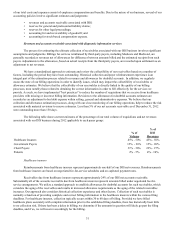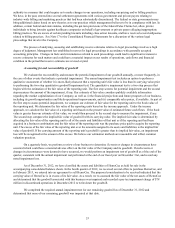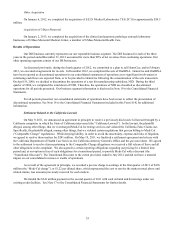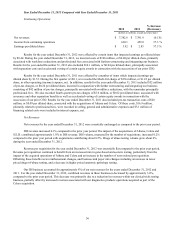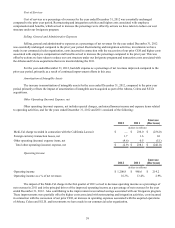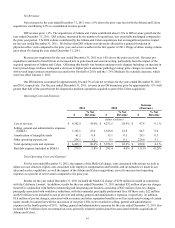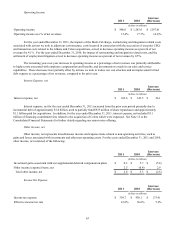Quest Diagnostics 2012 Annual Report Download - page 56
Download and view the complete annual report
Please find page 56 of the 2012 Quest Diagnostics annual report below. You can navigate through the pages in the report by either clicking on the pages listed below, or by using the keyword search tool below to find specific information within the annual report.53
authority in a manner that could require us to make changes in our operations, including our pricing and/or billing practices.
We have, in the past, entered into several settlement agreements with various government and private payers relating to
industry-wide billing and marketing practices that had been substantially discontinued. The federal or state governments may
bring additional claims based on new theories as to our practices which management believes to be in compliance with law. In
addition, certain federal and state statutes, including the qui tam provisions of the federal False Claims Act, allow private
individuals to bring lawsuits against healthcare companies on behalf of government or private payers alleging inappropriate
billing practices. We are aware of certain pending lawsuits including class action lawsuits, and have received several subpoenas
related to billing practices. See Note 17 to the Consolidated Financial Statements for a discussion of the various legal
proceedings that involve the Company.
The process of analyzing, assessing and establishing reserve estimates relative to legal proceedings involves a high
degree of judgment. Management has established reserves for legal proceedings in accordance with generally accepted
accounting principles. Changes in facts and circumstances related to such proceedings could lead to significant revisions to
reserve estimates for such matters and could have a material impact on our results of operations, cash flows and financial
condition in the period that reserve estimates are revised or paid.
Accounting for and recoverability of goodwill
We evaluate the recoverability and measure the potential impairment of our goodwill annually, or more frequently, in
the case of other events that indicate a potential impairment. The annual impairment test includes an option to perform a
qualitative assessment of whether it is more-likely-than-not that a reporting unit's fair value is less than its carrying value prior
to performing the two-step quantitative goodwill impairment test. The quantitative impairment test is a two-step process that
begins with the estimation of the fair value of the reporting unit. The first step screens for potential impairment and the second
step measures the amount of the impairment, if any. Our estimate of fair value considers publicly available information
regarding the market capitalization of our Company, as well as (i) the financial projections and future prospects of our business,
including its growth opportunities and likely operational improvements, and (ii) comparable sales prices, if available. As part of
the first step to assess potential impairment, we compare our estimate of fair value for the reporting unit to the book value of
the reporting unit. We determine the fair value of the reporting units based on the income approach. Under the income
approach, we calculate the fair value of a reporting unit based on the present value of estimated future cash flows. If the book
value is greater than our estimate of fair value, we would then proceed to the second step to measure the impairment, if any.
The second step compares the implied fair value of goodwill with its carrying value. The implied fair value is determined by
allocating the fair value of the reporting unit to all of the assets and liabilities of that unit as if the reporting unit had been
acquired in a business combination and the fair value of the reporting unit was the purchase price paid to acquire the reporting
unit. The excess of the fair value of the reporting unit over the amounts assigned to its assets and liabilities is the implied fair
value of goodwill. If the carrying amount of the reporting unit's goodwill is greater than its implied fair value, an impairment
loss will be recognized in the amount of the excess. We believe our estimation methods are reasonable and reflect common
valuation practices.
On a quarterly basis, we perform a review of our business to determine if events or changes in circumstances have
occurred which could have a material adverse effect on the fair value of the Company and its goodwill. If such events or
changes in circumstances were deemed to have occurred, we would perform an impairment test of goodwill as of the end of the
quarter, consistent with the annual impairment test performed at the end of our fiscal year on December 31st, and record any
noted impairment loss.
As of December 31, 2012, we have classified the assets and liabilities of HemoCue as held for sale in the
accompanying consolidated balance sheets. In the fourth quarter of 2012, we received several offers to purchase HemoCue, and
in February 2013, we entered into an agreement to sell HemoCue. The proposed consideration to be received indicated that the
carrying value of HemoCue is in excess of its fair value. As a result, we re-assessed the fair value of the net assets of HemoCue
and determined that the goodwill associated with this business was impaired and recorded a pre-tax impairment charge of $78
million in discontinued operations in December 2012 to write down the goodwill.
We completed the required annual impairment test for our remaining goodwill as of December 31, 2012 and
determined that none of our remaining goodwill was impaired at that date.



